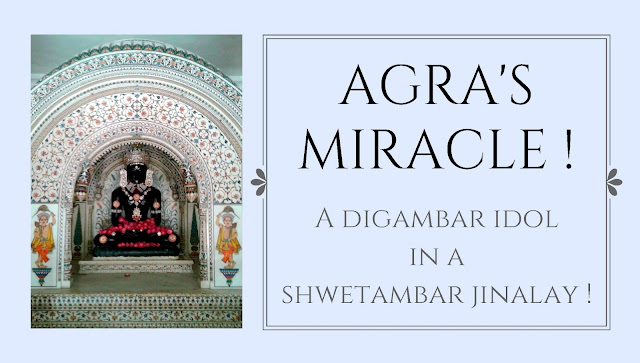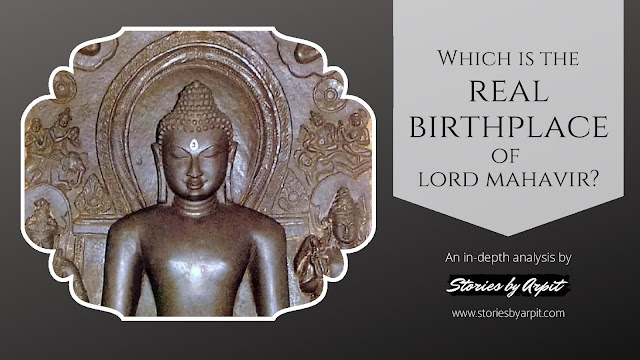Agra's Miracle !
At a time when the entire Jain
community remains divided in sub-sects viz. Shwetambar's, Digambar's,
Terapanthi's etc.; at a time when large disputes have occurred between these communities regarding ownership of ancient idols like Antrikshji and Keshariyaji) a rare picture of harmony can be witnessed in the ancient
city of Agra where a beautiful idol of Shri Shitalnath Bhagwan (probably having Digambar
origins) can be found installed in a Shwetambar Temple. This unique temple,
situated in the bustling Roshan Mohalla was built centuries ago in the reign of
the Mughal emperor Akbar and is dedicated to Shri Chintamani Parshwanath
Bhagwan. Read on to know more about this divine wonder.
Antiquity of the Temple
Once when the Mughal Emperor, Akbar
saw a procession in the honor of Champa shravika’s (a Jain lay
woman) six month fast, he was greatly intrigued at this feat and asked the
royal servants to welcome her to his palace. From his ministers he came to know
that after Lord Mahavir, it was Champa shravika who had performed such a
rare penance. Akbar was astonished at the fact that one could survive without
food for a continuous period of six months; since he knew too well as to how
extremely difficult it was to observe ‘Roza’ for a month despite the
permission for a meal every night. The shravika
explained to the Emperor that such a difficult ‘tapasya’ (penance) was
possible only because of the blessings of her revered guru Acharya Shri
Hirvijay Surishwarji Maharaja (“Acharya Shri”).
This event created a great
reverence in Akbar’s mind for Jainism and in order to gain more knowledge about the
religion, he humbly invited Acharya Shri to his
capital, Fatehpur Sikri and Agra. At that time, Acharya Shri was in the town of Gandhar
in Gujarat and believing that there was an opportunity to spread the message of
Jainism in the court of the Mughal Empire, he started the journey towards the
capital. After an arduous ‘vihaar’ of nearly 1,100 km on foot, Acharya
Shri and his disciples reached the capital in Vikram Samvat 1639 (~1582 AD).
 |
| Emperor Akbar welcoming Acharya Shri Hirvijay Surishwarji Maharaja at his palace (Source: tattvagyan.com) |
On reaching the palace, Acharya
Shri was given a grand welcome by the Emperor. Akbar, along with his three
princes descended from their thrones and paid their respects. In honour of
arrival of such a learned guru, expensive carpets were laid out in the royal
palace but Acharya Shri refused to walk on them as such an act might kill the
insects moving under the cloth. Akbar immediately ordered the carpets to be
removed and found out that there were innumerable ants underneath the carpets. Akbar was deeply moved witnessing such compassion towards the tiniest of creatures.
In the next few months, Acharya
Shri gave regular discourses to Akbar on principles of Jainism, which
influenced his thinking a lot. Acharya Shri persuaded the emperor to abolish
the Jiziya (a tax on pilgrimages like Shatrunjay, Girnar, Taranga,
Kesariyaji, Abu, Rajgruhi, Sammet Shikharji etc) and free the birds &
animals caged in his menagerie. Akbar gave up hunting and abstained from meat-eating on majority of days.
He also declared firman’s (orders) banning the killing of animals during
Paryushan and on Mahavir Janma Kalyanak. The emperor was so impressed by
Acharya Shri that he conferred upon him the title of "Jagad Guru"
(“the Teacher of the world.")
 |
| Mulnayak Shri Chintamani Parshwanath Bhagwan carved from the Yashab stone. (Source: Google) |
Subsequently, Acharya Shri stayed in Agra to propagate Jainism and inspired many affluent noblemen and merchants to construct a grand jinalay in the bustling Kinari Bazar near the Agra Fort which was situated on the banks of the Yamuna river. Preparations of constructing a grand temple were initiated and craftsmen from various parts of the empire were called upon to design the temple. The idol of the Mulnayak (main deity) Shri Chintamani Parshwanath Bhagwan was carved out from a single rock of a rare gemstone Yashab (Jade). In ~1583 AD, the Anjanshalakha & Pratishtha Mahotsav was conducted in the midst of grand celebrations under the holy presence of Acharya Shri.
 |
| The divine idol of Shri Shitalnath Bhagwan (Source: Shri Sunil Kumar Dugar) |
Adjacent to the Garbha Griha
(Sanctum Sanctorum) of the temple, a divine (probably Digambar) idol of Shri
Shitalnath Bhagwan carved out of Kasauti Patthar (Touch stone- used to test the purity of gold) was installed in
1648 AD on a marble throne brilliantly inlaid with Pietra-Dura
work (Parchin-Kari) which has more intricate designs
than those inlaid on the Taj Mahal. Rare and precious gemstones like Lapis
Lazuli, Onyx, White Jasper, Red Jasper, Jade, Tiger Stone, Torques, Jaisalmer
stone among others were used in this inlay work.
But
the question arises, why was the (probably Digambar) idol of Shri Shitalnath
Bhagwan installed in a Shwetambar temple? The answer lies here~
In 1648, Akbar’s grandson, Shah Jahan initiated
the construction of Jama Masjid (a mosque) near the Chintamani
Parshwanath Jinalay. When the foundation of the mosque was being laid, an ancient
idol of Shri Shitalnath Bhagwan was excavated during the process. The idol dated back to the Mauryan ages and surprisingly had distinct features of both the Digambar and Shwetambar traditions. However, as the idol was 'Nirvastra' (without any ornaments and clothes) the Mughals asked the Digambar community to take possession of the idol.
Eminent persons from the Digambar community tried to move the idol from the ground; hundreds of labourers were deployed, but despite numerous attempts, the idol refused to bulge. In dilemma, the authorities declared to handover the idol to anyone who could move it.
Eminent persons from the Digambar community tried to move the idol from the ground; hundreds of labourers were deployed, but despite numerous attempts, the idol refused to bulge. In dilemma, the authorities declared to handover the idol to anyone who could move it.
 |
| Jama Masjid, Agra (Source: Wikimedia Commons) |
Witnessing this, one Yati maharaj (A spiritually advanced layman who has not taken the Shwetambar Diksha but follows certain rules alike a monk) came forward and after conducting
proper rituals requested the Kshetrapal Dev (celestial being
entrusted with the protection of a certain area) and Adhishtayak dev (celestial
being dedicated to a Tirthankar) to help them in this process. After many days
of ritualistic penance, the divine idol of Shri Shitalnath Bhagwan was
recovered from the ground and the Yati Maharaj ceremonially installed
this idol in the nearby Chintamani Parshwanath Bhagwan's Jinalay.
Till this day, the miraculous idol of Shri Shitalnath Bhagwan is deeply revered by both the Digambar and Shwetambar communities. Hundreds of devotees flock to this Jinalay daily and feel the divine calmness and tranquility just by a mere glimpse of the Lord’s idol.
It is also interesting to know that the idol is devoid of Chakshu’s as many people who tried to place have failed to do so. The idol has such divine powers that one devotee named Shrichandji (who was also entrusted to guard the temple) was cured of his blindness just by worshiping the lord! It is also believed that the Adhishtayak Dev’s fulfil the wishes of the devotees who worship this idol for a constant period of 40 days.
The Jinalay complex also houses a Gyaan Bhandar, Upashray, Dharamshala and Bhojanshala and can be reached from the Agra fort railway station which is just a 5 minute walk from the temple. Further, the idol of Shri Shitalnath Bhagwan installed in the famous Badridas Temple in Kolkata was also obtained from the an underground vault below the temple.
Watch a video of the daily Abhishek conducted on the divine idol of Lord Shitalnath in the presence of devotees-
It is also interesting to know that the idol is devoid of Chakshu’s as many people who tried to place have failed to do so. The idol has such divine powers that one devotee named Shrichandji (who was also entrusted to guard the temple) was cured of his blindness just by worshiping the lord! It is also believed that the Adhishtayak Dev’s fulfil the wishes of the devotees who worship this idol for a constant period of 40 days.
The Jinalay complex also houses a Gyaan Bhandar, Upashray, Dharamshala and Bhojanshala and can be reached from the Agra fort railway station which is just a 5 minute walk from the temple. Further, the idol of Shri Shitalnath Bhagwan installed in the famous Badridas Temple in Kolkata was also obtained from the an underground vault below the temple.
Watch a video of the daily Abhishek conducted on the divine idol of Lord Shitalnath in the presence of devotees-
The co-ordinates of the temple are as below ~
Shri Chintamani Parshwanath Bhagwan Shwetambar Jain Mandir Pedhi
Address: 3/285,Roshan Mohalla, Jama Masjid Road, Hing ki Mandi,
Mantola, Agra, Uttar Pradesh, Agra, Uttar Pradesh 282003
Phone: +91-0562-2254559
The author is thankful to Shri Vinay ji Choradiya (Agra) and Shri Rahul Gandhi (Varanasi) for providing valuable inputs for this post.











Amazing 😍
ReplyDeleteThanks a lot ! :)
DeleteVery much informative article and great research!!
ReplyDeleteThank you so much :)
DeleteGreat
ReplyDeleteThanks :)
DeleteThx Mr. Authoro
ReplyDeleteThx Mr. Author
ReplyDeleteThanks for the valued information Sir ;)
DeleteVisit &divine darshan of Shitalnath Bhagwan every sunday during my initial posting at canara bank belanganj agra branch during 1972-73 still linger in my memory. This is also the only jain temple where every visitor buys a small earthen ghee ka deepak & offer gracefully to Prabhuji.
ReplyDeleteWow. That's great
DeleteSo awesome..!
ReplyDeleteบาคาร่าออนไลน์
gclub casino
Thanks for sharing dis with us.. keep doing dis ...Really great work
ReplyDeleteThank you so much!
DeleteVery nice.......
ReplyDeleteOne same situation exists in Dewas, Madhya Pradesh (Near Indore), where a digambar idol of Shantinathji is worshiped in Samprati kaalin Adeshwar bhagwan's jinalay...
Thank you. Please share more information on the same.
DeleteAmazing ! :)
ReplyDeleteThank you!
Deleteभाई,
ReplyDeleteनतमस्तक हूं, अभिभूत हूं, कितना महान धर्म है और कितना सुंदर और व्यवस्थित तरीके से आपने पूरी जानकारी को हमारे बीच में रखा और हमें बिलकुल सजीव और साक्षात् प्रतिमा जी के दर्शन का लाभ दिया आपका भी ढेर सारा आभार....
Apka khub khub Abhar!
Deleteउक्त प्रतिमा जी श्वेतांबर प्रतिमा है एवं उक्त प्रतिमा जी पर श्वेतांबर मान्यता के अनुसार ही पूजा होती है। केवल भ्रम की स्थिति पैदा करने के लिए यह तथ्य गढे गये हैं। जिससे दोनों पंथों में आपस में विवाद हो। दोनों पंथों के लोगों में प्रतिमा जी के प्रति लगाव है। इसी भावना को ध्यान में रखकर चक्षु नहीं लगाये गये हैं।
ReplyDelete